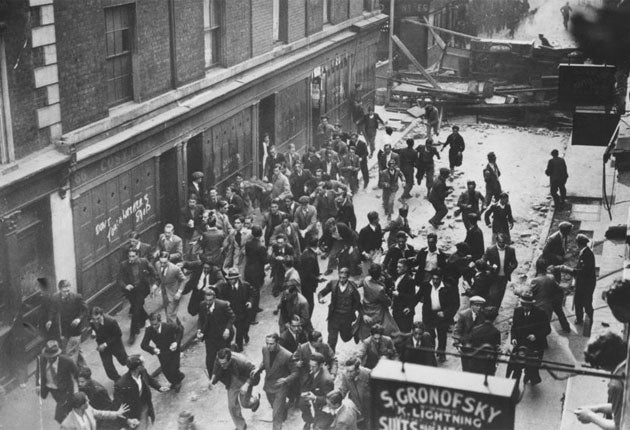'How we defeated the blackshirts in The Battle of Cable Street'
It is 75 years since Londoners banded together to block a march by Sir Oswald Mosley's fascists

Your support helps us to tell the story
This election is still a dead heat, according to most polls. In a fight with such wafer-thin margins, we need reporters on the ground talking to the people Trump and Harris are courting. Your support allows us to keep sending journalists to the story.
The Independent is trusted by 27 million Americans from across the entire political spectrum every month. Unlike many other quality news outlets, we choose not to lock you out of our reporting and analysis with paywalls. But quality journalism must still be paid for.
Help us keep bring these critical stories to light. Your support makes all the difference.
For a long time, a tiny red plaque on the wall of a building was the only clue in the otherwise nondescript street. Bounded by council estates, a stone's throw from Tower Bridge in London, the anonymity of Cable Street stands in marked contrast to the events commemorated by the plaque – the "battle" fought there in October 1936.
In truth, it was more a riot, as an estimated 300,000 people, mostly inhabitants of the adjoining east London neighbourhoods, successfully sought to prevent several thousand black-shirted followers of Sir Oswald Mosley's British Union of Fascists (BUF) marching provocatively through the predominantly Jewish and Irish area.
The disorder that erupted when the march with its 10,000-strong police escort was blocked and turned back is a milestone in the histories of popular resistance and the left. For many, it marks the turning point in the fortunes of fascism in Britain which many feared was on the brink of success enjoyed by parallel movements elsewhere in Europe, notably in Germany and Italy.
Few can claim to have seen the events of that day with their own eyes. Max Levitas is one of the handful who remain. He will be among the guests of honour at next month's rally and exhibition to mark the 75th anniversary. Still a local resident, he remembers that day as if it were yesterday. "It was a great sight to see: a victory against both the state and the fascists, stopped in their tracks from marching through the East End of London," he said. "If they had marched through, there would have been deaths."
A former secretary of the Mile End Young Communists, Mr Levitas, a sprightly 96, was already a veteran Mosley opponent, having been convicted and fined for daubing Nelson's column in Trafalgar Square with paint exhorting people to fight fascism.
News of the proposed march through the East End neighbourhood was opposed by local people. Despite warnings of violence, the government refused to ban the march, and a large police escort was provided to ensure that the blackshirts passed through.
"There wasn't a house or flat in Stepney which didn't have a leaflet calling for opposition put through the door. That's how we got to the people of Tower Hamlets. That's how we got them on to the streets," he said. "The police tried to come through Cable Street to make way [for the Blackshirts] and take some of the side streets. But they couldn't do it," said Mr Levitas. "There were so many people out in force. The people in Cable Street were throwing rubbish out the windows – manure, rotten vegetables. Women were emptying their chamber pots!"
Mr Levitas witnessed police horses fall as locals, including women and children, threw marbles down the streets and under their hooves. Shopkeepers used their fruit and vegetable carts as barricades, while a tram car was tipped over in Commercial Street.
Eventually, after dozens of pitched battles, Mosley admitted defeat and his supporters turned back. "We were told at 3pm that the march wouldn't happen through the East End. There was much cheering. People put children on their shoulders. Everyone was happy. They were shouting 'Come again and you'll get the same'," he remembers.
Mosley continued to try to organise marches, policed by his own blackshirts. But the government, unhappy at the trouble that followed them, responded by passing the 1936 Public Order Act, which forced the BUF to abandon its uniforms and paramilitary tactics.
Mr Levitas has no plans to give up what he calls "the struggle". "I want to see everybody living to 96! I feel great! Great, insofar that I am alongside the majority of people who want a better life. You have to understand that we don't get things without struggle. There is always a struggle."
The lessons of Cable Street, he insists, remain relevant today. "Through Cable Street, people learn of the struggles that happened in the Thirties. That has got to be applied today. People have got to be brought together in the struggle against racism."
Join our commenting forum
Join thought-provoking conversations, follow other Independent readers and see their replies
Comments